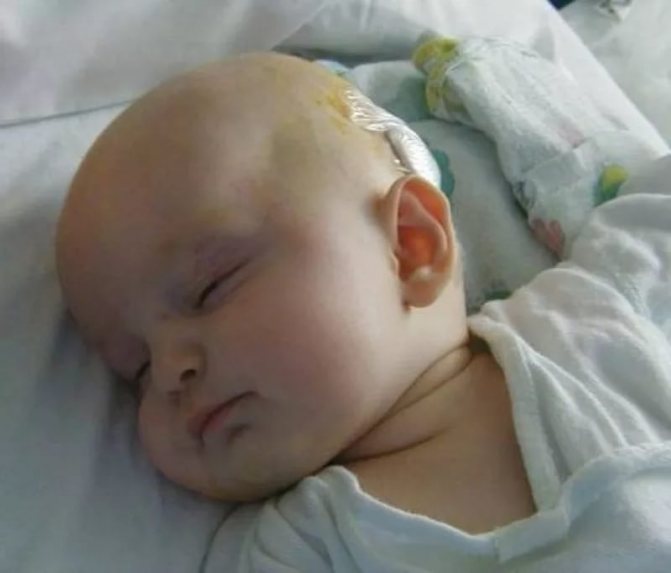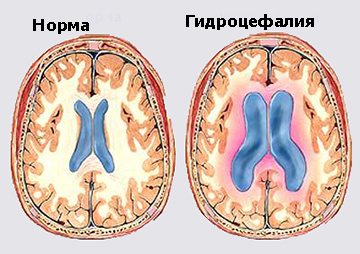What is GGS?
In a healthy body, all systems and organs work as intended by nature, with their own characteristics and certain sequences of various processes. Sometimes it happens that some system begins to work incorrectly, this leads to the development of problems in the functioning of one or another organ or the system itself, which affects the well-being and health of a person. Hypertensive-hydrocephalic syndrome is a violation of the production of cerebrospinal fluid (CSF), its exchange and absorption with gradual accumulation in the ventricles and under the membranes of the brain. Hydrocephalus is formed, leading to hypertension - increased intracranial pressure. All together it is a hypertensive-hydrocephalic syndrome.
Diagnostics
Pathology can be diagnosed using transcranial ultrasound
The diagnostic tool of choice used to visualize the ventricular system of the brain is computed tomography. MRI is done to detect malformations, cysts or tumors that lead to hydrocephalus.
Other methods for diagnosing childhood or adult hydrocephalus:
- measurement of intracranial pressure;
- transcranial ultrasound: in children it helps to accurately identify the size of the ventricles and possible causes of hydrocephalus;
- assessment of fundus vessels;
- lumbar puncture: taking 30-50 ml of cerebrospinal fluid from the spinal canal helps measure the pressure in the CSF system;
- neurological tests;
- adaptation test: by changing the volume and adding external fluid to the CSF system, the adaptability of the system to various changes is examined.
Forms of the syndrome
Hypertensive-hydrocephalic syndrome is a special condition of the brain caused by the accumulation of cerebrospinal fluid (CSF) and the subsequent increase in intracranial pressure (hypertension). Clinicians identify several types of this symptom. The main division is the open (non-communicating) and closed (communicating, obstructive) form of the disease, characterized by the characteristics of the collection of cerebrospinal fluid.
Doctors divide the open, non-obstructive form of hypertensive-hydrocephalic syndrome into three types:
- hypersecretory, determined only by the presence of choroid plexus papilloma, as well as in acute inflammatory diseases of the brain and its membranes;
- hyporesorption (aresorptive);
- hypersecretory-hyporesorption (mixed) form.
Closed, in turn, is divided into:
- monoventricular - asymmetric;
- biventricular - both ventricles and interventricular spaces are affected;
- triventricular - when the cerebral aqueduct is blocked, the lateral ventricles are dilated;
- tetraventricular - all parts of the ventricular system, interventricular foramina, and cerebral aqueduct are affected.
Mild hypertensive-hydrocephalic syndrome is an absolutely conventional, everyday term. It implies no changes in the brain due to the presence of HGS, with a slight increase in intracranial pressure and a positive potential for recovery.
Possible causes of the disease
Increased intracranial pressure as a result of the accumulation of excess cerebrospinal fluid is called hypertensive-hydrocephalic syndrome. In children and adults, this pathology can develop for many reasons:
- metabolic disease;
- neoplasms;
- hematomas in parts of the brain;
- hypertension;
- stroke;
- viral diseases - encephalitis, malaria;
- splintered injuries of the skull;
- parasitic cysts.
Reasons for violation
Hydrocephalus can be congenital or acquired.
The causes of congenital pathology are:
- developmental disorders in the womb (neural tube defects);
- Arnold-Chiari malformation (improper development of the brain structures of the posterior cranial fossa);
- Dandy-Walker syndrome;
- malformations (vascular development abnormalities).
Even infectious diseases in a pregnant woman can cause the development of hydrocephalic syndrome in small newborns. Hydrocephalus can develop as a result of cerebral hemorrhage in premature babies.
Acquired hydrocele of the brain has the following main causes:
- cerebral hemorrhage;
- meningitis;
- tumors.
HGS in newborns
Hypertensive-hydrocephalic syndrome in infants is a neonatology term that defines a whole set of indicators that characterize the possibility of suggesting an increase in intracranial pressure in a newborn as a result of the accumulation of cerebrospinal fluid in the brain. In the vast majority of cases, this problem develops in the baby while still in the womb. Its reasons may be:
- hypoxia (lack of oxygen) of the fetus;
- pathologies of child development as a result of genetic diseases, drug, alcohol or tobacco intoxication of the fetus;
- fetal injuries;
- trauma when passing through the birth canal.
The risk of a child developing HGS increases sharply in the following cases:
- early or, conversely, late birth;
- toxicosis (eclampsia and preeclampsia);
- pregnancy pathologies (placenta previa, placental abruption);
- premature discharge (more than 12 hours) of amniotic fluid;
- chronic maternal illnesses;
- viral or infectious diseases suffered by the mother during pregnancy;
- multiple pregnancy.
The presence of problems in the development of the newborn is assessed using a special technique called the Apgar scale. It considers a set of certain indicators using a point system. A child born with HGS has scores within 6 points, while an absolutely healthy newborn has 10 points.
Complications in the treatment of hydrocephalic syndrome

After bypass surgery, some complications may appear in the form of:
- hyperdrainage state;
- shunt occlusion at different levels;
- seizures of epilepsy;
- infection of the shunt with the further development of certain diseases, etc.
Today, in case of occlusive hydrocephalus, endoscopic surgery is used to restore the patency of the cerebrospinal fluid. Removal of shunts occurs very rarely.
Preventive measures for hydrocephalic syndrome If a child is diagnosed with infections such as syphilis, meningitis, encephalitis, after treatment, preventive measures should be aimed at them. It is also advisable to eliminate stress and overwork from a child’s life. In case of suspicious behavior of a child, seek advice from a pediatrician, neurologist, surgeon, or neonatologist.
HGS in children
Impaired circulation of cerebrospinal fluid, its accumulation in the interventricular spaces and under the membranes of the brain is called hypertensive-hydrocephalic syndrome. In babies born with this health problem, increased intracranial pressure and hydrocephalus affect not only their health and development, but also their appearance. The volume of the baby's head exceeds normal values by 1-2, and in some cases more, centimeters. Another characteristic external sign is sunken eyes and overhanging brow ridges. But HGS can be not only a congenital disease, but also acquired at an older age. For children from 3 to 12 years old, characteristic signs of HGS will be:
- morning headache;
- disorientation in space during headache attacks;
- lethargy and drowsiness;
- inattention;
- memory impairment;
- manifestation of photophobia and fear of loud sounds;
- muscle tone;
- strabismus appears.
This condition often develops after infectious or viral diseases, as well as head injuries.
Symptoms of hydrocephalic syndrome

The clinical picture develops very quickly, which is facilitated by the anatomical and physiological characteristics of the child’s brain: pliability and plasticity.
The clinical picture of HS in the first days of life usually accompanies the course of an acute period of moderate hypoxic encephalopathy or periventricular hemorrhage. In this case, the child is born in a rather serious condition, which is confirmed by the low score of the main indicators of vitality on the Apgar scale - 4-6 points (with a norm of 10 points).
Typical manifestations of HS in an infant are considered to be a disproportionately rapid increase in head circumference, exceeding normal values by 1 - 2 cm, protrusion and tension of the fontanelle (physiological gap between the bones of the skull), expansion of the sagittal suture (connection of the right and left parietal bones) over half a centimeter. In addition, the head of a newborn with HS can acquire a specific shape - with an overhanging occipital part (dolichocephalic type), or with enlarged frontal tubercles (brachycephalic type).
A neurological examination reveals a number of signs confirming increased intracranial pressure and an increase in the volume of fluid in the brain:

- Graefe's symptom (delay in lowering the eyelids);
- spontaneous Moro reflex (stretching arms to the sides);
- periodic horizontal nystagmus (involuntary high-frequency eye vibrations);
- “setting sun” symptom (downward displacement of the eyeballs exposing a wide strip of sclera);
- congestion of the saphenous veins on the head and (or) increased venous pattern;
- convergent (converging) strabismus;
- muscular dystonia, predominant in the distal arms and legs;
- drooping hands (symptom of “seal feet”);
- symptom of “heel feet” (the ability to bend the foot until it touches the shin).
In the majority of newborn children, objective signs of HS affect their general condition and lead to disturbances in behavior and normal physiological functions. Such children sleep restlessly, shudder for no reason, may be agitated or, on the contrary, lethargic, refuse to breastfeed, or scream shrilly.
After feeding, a child with GM may spit up like a fountain, even in cases where the amount of food meets his needs. Trembling of the chin is often observed, worsening when crying or during feeding. In severe cases, seizures are possible.
During HS, there are two possible options:
- In the first case, the symptoms of hydrocephalus or hypertension disappear within a year or significantly regress. In this case, they speak of a favorable outcome of the disease, which was based on functional disorders.
- In the second, unfavorable variant of the development of HS, the symptoms intensify over time, forming a clinical picture of organic brain damage - hydrocephalus.
HGS in adults
Hypertensive-hydrocephalic syndrome is not only a problem for newborns and children. It can also develop in adults. The causes of this condition in adults can be head injuries, diseases, tumors, and large aneurysms. Hypertensive-hydrocephalic syndrome in adults manifests itself as follows:
- severe headache, recurring more and more frequently;
- systematic nausea and vomiting;
- visual disturbances;
- apathy;
- irritability;
- convulsions;
- dizziness;
- loss of consciousness;
- coma.
Clinical picture
An increase in cerebrospinal fluid and its accumulation in the interventricular spaces and under the membranes of the brain leads to an increase in intracranial pressure. This condition is called hypertensive-hydrocephalic syndrome. Its signs are clearly visible during a special examination - computed tomography: expansion of cavities with cerebrospinal fluid and compression, reduction of the brain matter. It is these processes that serve as the basis for the clinical picture of HGS - headaches, nausea, visual impairment, attention, ability to process received information, apathy and irritability.
A peculiarity of the main symptom - headache in both children and adults - is its manifestation in the morning, when a person wakes up and gets out of bed. A change in body position from horizontal to vertical causes difficulty in the circulation of cerebrospinal fluid, causes an increase in intracranial pressure and, as a result, headaches. Significant increases in ICP can lead to nausea, vomiting, seizures, and even coma. Older patients report impaired memory and attentiveness, disorders of the ability to process information received in any way, which leads to problems in professional activities and at home. For infants, observing the clinical picture boils down to anxiety, crying, and the child may spit up like a fountain. The baby's sleep is disturbed, he often wakes up and is capricious. Any health problems require not self-medication, but proper diagnosis.
Diagnosis of HGS
Hypertensive-hydrocephalic syndrome is a rather complex problem in terms of diagnosis; it is difficult to establish even a preliminary diagnosis based on external signs and the patient’s medical history. The only thing is congenital hydrocephalus and, as a consequence, an increase in intracranial pressure is visualized by external signs: an increase in the size of the head, deep-set eyes, overhanging brow ridges. To make an indirect diagnosis of HGS, it is necessary to conduct a comprehensive examination:
- radiography of the skull to detect deformation of the skull bones;
- consultation with an ophthalmologist to identify swelling of the mucous disc and vascular changes;
- echoencephalography.
Accurate diagnostics that can show an increase in the volume of cerebrospinal fluid and an increase in intracranial pressure are carried out only in specialized medical institutions involved in neurosurgery. But since HGS is only a syndrome caused by some pathology or disease, it is necessary to establish it. Adequate treatment of HGS is carried out based on the treatment of the underlying disease or pathology.
Consequences of HGS
Hypertensive-hydrocephalic syndrome in newborns is a dangerous condition that can lead to disability and death of the child. The development of intracranial pressure leads to damage to brain tissue or its membranes. The possible consequences of HGS are influenced by the underlying cause of hydrocephalus and cerebral hypertension. It can be quickly resolved with high-quality treatment and not cause serious consequences, or it can have a serious pathology of brain development, which in any case leads to a hopeless prognosis.
For adults, the root cause of the appearance of HGS and the potential possibility of getting rid of the cause are also important. The prognosis of HGS and its consequences will depend on the clinical picture of the underlying disease.
Diagnosis of the disease
A thorough initial examination by a pediatrician and a neurologist allows one to suspect that a child’s body is not developing as expected for its age.
Once a qualified specialist suspects the possibility of developing hydrocephalic syndrome, a series of studies are prescribed to confirm or, conversely, refute this pathological process.
The diagnostic algorithm for hypertensive-hydrocephalic syndrome is based on laboratory and instrumental studies such as:
- Ultrasound, which examines the condition of the ventricles of the brain, their sizes and shapes;
- spinal canal puncture;
- magnetic resonance imaging or computed tomography of brain structures;
- ophthalmological assessment of the vessels of the fundus and optic nerve.
The diagnostic algorithm is prescribed on an individual basis.
If the child's parents notice strange behavior or condition of their baby, they should seek medical advice as soon as possible.
Treatment
Therapy of hypertensive-hydrocephalic syndrome uses an integrated approach. Treatment is prescribed by a neurologist together with a neurosurgeon and ophthalmologist. The patient is prescribed drugs that remove excess amounts of cerebrospinal fluid - special-purpose diuretics, nootropic drugs that improve cerebral circulation, sedatives. Massages and physiotherapeutic procedures are also prescribed. In extreme cases, treatment is carried out with surgery. Since the prognosis of HGS can be critical, it is necessary to take timely measures both to get rid of hydrocephalus and cerebral hypertension, and to eliminate the causes that caused them.
Hypertensive-hydrocephalic syndrome is a serious health problem for both adults and children. It can arise for various reasons and have a complex prognosis for treatment and consequences. You can’t ignore the primary signs - headaches, irritability, baby crying and moodiness. A competent examination and timely prescribed treatment will help compensate for the problem with the least pathological consequences.
Treatment of hydrocephalic syndrome in children
If the diagnosis is nevertheless confirmed, parents need to muster their will and immediately begin treating their child with a neurologist, neurosurgeon and, if necessary, an ophthalmologist, because delay will not lead to anything good.
Young patients who are not yet six months old require outpatient treatment. You need to be prepared for the fact that this process is quite long (up to several months).
Treatment of hydrocephalic syndrome in children includes the following therapeutic measures:
- Prescribing diuretics to reduce the production of cerebrospinal fluid and remove its excess from the body;
- Taking medications that improve cerebral circulation;
- Use of sedatives;
- Using the services of a good massage therapist.
In more complex situations, treatment of hydrocephalic syndrome in children involves surgical intervention: the obstruction that prevents the outflow of fluid is removed or, if such an operation is impossible, bypass surgery is performed on the ventricles of the brain.










